Giardini La Mortella: A lost world of near-tropical beauty tucked away on an Italian isle
Steven Desmond describes the cross-fertilisation of exuberant experimentation and cool practicality that produced La Mortella, one of the destinations of a Country Life readers’ tour later this year.
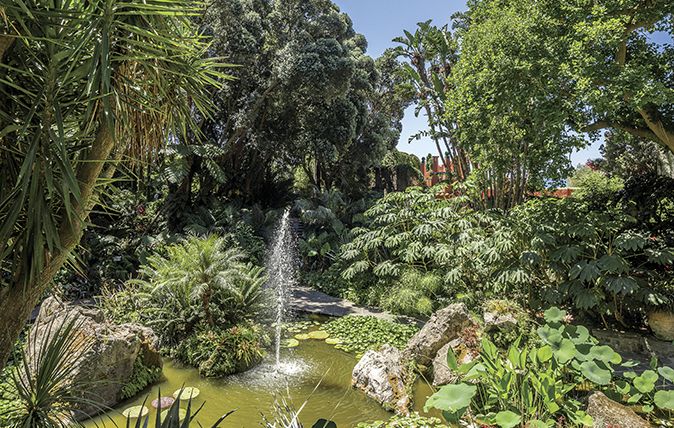

The island of Ischia, a volcanic rock an hour’s journey from the shore in the Bay of Naples, has several claims to fame. It was, for instance, the place where Greek settlers in Antiquity first introduced the grapevine into Italy. Then again, it’s popular with visitors, who like to sit in its sulphurous pools of warm mud heated by the magma not far below.
In modern times, however, another attraction has brought pilgrims over the sea: a magnificent private garden in the form of a lost world of near-tropical beauty.
When the composer Sir William Walton and his wife, Susana, first arrived in Ischia, their life was filled with uncertainties. Sir William valued the peace and quiet he needed to compose and largely left the practicalities of life on an island without water or petrol to his industrious wife. Eventually, in 1956, they bought a plot of ground in what their friend Sir Laurence Olivier described as ‘a south-facing stone quarry’, with neither house nor garden. They were lucky to secure the advice of the illustrious garden designer Russell Page, then at the height of his career, who laid down the bones of the garden.
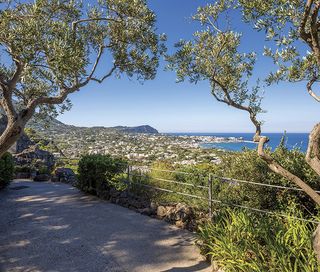
As time went on, the Waltons worried about the size of his fee. Page replied: ‘Susana, I have not yet finished the garden. When I do, I will let you know.’ He was still working on it three decades later when he died, never having submitted his invoice. This was a labour of love.
Where Page was cool, thoughtful, orderly and practical, Susana was energetic and brimming with ideas. They must have been marvellous to watch together. His calm professionalism balanced and overlaid with her effervescent style has produced, gradually over many years, one of the great gardens of the world.
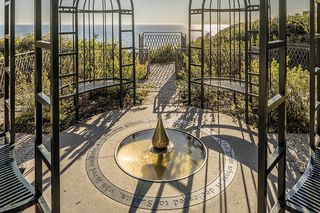
The property is quietly placed down a country lane between Forio and Lacco Ameno, high on the island, and makes no great show from the roadside. The approach to the garden passes through a rich mixture of glittering greenery like an overture preparing us for what we’re about to see.
Then, we arrive at the first scene of Page’s unfolding route: a circular pool framed by benches, with a straight walk projecting ahead. Down the centre of the walk is a long, slender rill. The way ahead is clear.
Sign up for the Country Life Newsletter
Exquisite houses, the beauty of Nature, and how to get the most from your life, straight to your inbox.
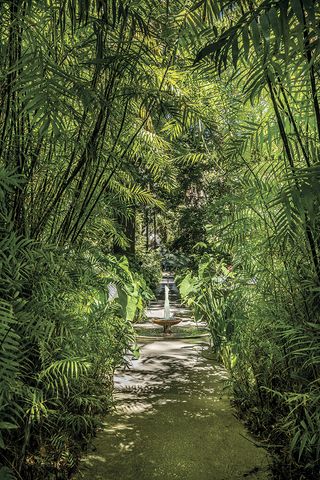
So far, so Russell Page, but all this is set in a giant jungle of exotic forest trees underplanted with flowers and foliage from the tropical zones of the world. The huge and prosperous leaves of Colocasia, like Sir Galahad’s shield, rise behind the benches. An immense straight trunk of Chorisia, leading up like a telegraph pole to brilliant pink flowers against the blue sky, catches the eye along the walk.
This tree, like Susana herself, is a native of Argentina; it was grown by her from seed, which seems barely credible now. It’s her living memorial in this garden, along with the huge Norfolk Island pine that first came here as a Christmas table decoration. How thrilled she would be to see them now.
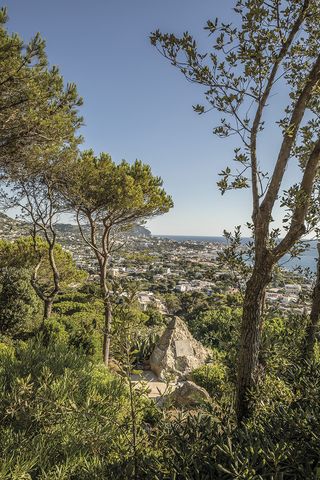
When the project began, the water supply was uncertain, so the fountains had to wait. In time, things improved and Sir William clambered about fiddling with them himself.
When Page saw them, he was unimpressed: pipi de chat was his response. Now, the fountains can be heard all over the garden as they gush and bounce, flashing in the sunlight. They also serve to lead the visitor along the route through the garden, from one source of light and sound to the next.
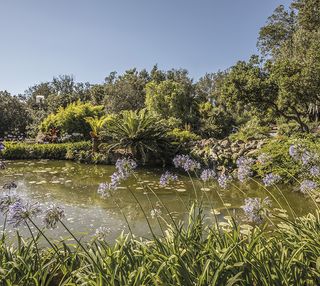
The centrepiece of the lower garden is an oval-shaped pool with another jumping fountain splashing over richly planted rocks. The brilliance of flowering shrubs is all around, from the exotic flowers of South American bromeliads to the arching red flowers of Russelia, happy everywhere it can find sunshine and warmth.
High above all this tower the many species of palm, of which Susana favoured those with blue-grey fronds, and the solitary magnificence of Erythrina, with its scarlet pea-flowers, visible from many parts of the garden, both from below and above.
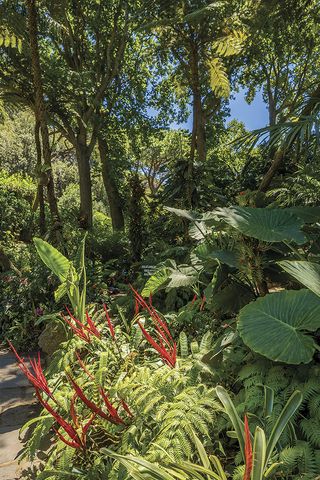
A little path leads quietly away to a sideshow in the form of the Victoria house. This is a conservatory boasting a pool planted with that ever-fascinating annual the giant Amazonian waterlily Victoria amazonica, forever associated with the genius of Joseph Paxton.
The great pink flowers – which arise, open and decline in three days – are overlooked by a dramatic stone face reminding us of Façade, the jazz-rap with words by Edith Sitwell that made Sir William’s name in 1923. It was as controversial then as it is now: Noël Coward stalked out of the first performance.
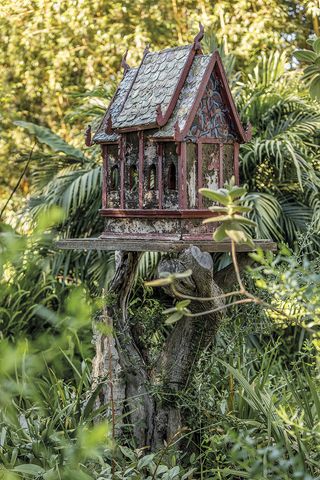
This centrepiece of Page’s layout is overseen by the house, which is built into the stone cliff. When it was new, opinions varied. Neighbours nicknamed it la caserma: the barracks. Page was reminded of a Minoan palace. The whole thing is largely invisible now, shrouded in foliage and surrounded by the chirping and cawing of aviary birds of one kind or another, more evocations for Susana of her far-distant home.
If this were the end of the garden, we would be well satisfied, but Susana’s fuse kept burning long after her designer and husband had left the stage. The upper part of the garden, above the house and accessed by a series of ramps and staircases, is where she took control herself. Pools, temples, statues, memorials, reliefs and yet more brilliantly rich planting seem to go on forever in an unfolding series of compartments across bridges, in alcoves and in hidden corners.
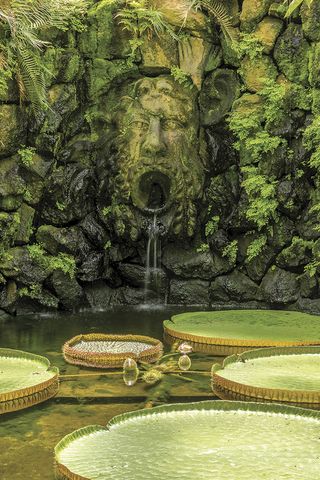
William’s famous rough-pyramid memorial gazes out over the spectacular view over Forio harbour and up to the forested mountain. Susana herself is commemorated by, among other things, a lovely relief of the Three Graces.
The real surprise comes in the interior of the Temple of the Sun. This was commissioned by Susana, herself a lifelong sun-worshipper, from Simon Verity and consists of two large grotto chambers filled with Cocteau-like inscriptions and visionary images drawn from ideas associated with her husband’s long musical career. Susana herself surely puts in an appearance in one corner as the Cumaean Sibyl, uttering prophecies from her fume-filled cave.

The topmost part of the garden verges on the surreal. It’s a little unconventional to place pools on the top of a cliff, but Page’s restraining influence was gone now and Susana could do what she liked. The theatrical scenes are cleverly separated from each other by planting of sublime beauty, mingling agapanthus, hydrangeas and proteas in well-structured profusion.
Blue Egyptian waterlilies spread across a pool as a bronze crocodile slowly descends its banks. A cat sleeps on an oriental bird table, blissfully unaware both of passing visitors and the purpose of the structure. An elaborate Thai temple, surrounded with the giant pale-pink flowers of the lotus, provides a quiet space in which to reflect and consider the varied imagery all round.
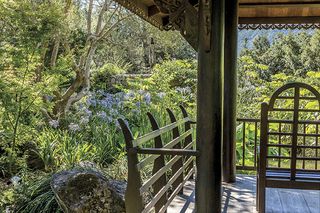
The last and most adventurous project of all was the outdoor concert stage, perched high on the cliff edge with just the panoramic view over the island and the sea beyond. Susana always intended this place to be a shrine to her husband’s music and their life together. We are privileged to be admitted to this private paradise.
Join Country Life on a tour of La Mortella and the Amalfi coast this autumn
In association with Boxwood Tours, Country Life is delighted to announce its tour this autumn to the spectacular Bay of Naples and Amalfi coast, taking in the islands of Ischia and Capri. This tour of stimulating contrasts and richly varied gardens is taken at a leisurely pace. Our visit to Ischia and the glorious gardens of La Mortella includes a concert and a private boat taken across the bay brings us to Anacapri and San Michele, the garden of Axel Munthe, made famous by his eponymous book. We will climb narrow paths to an Amalfi lemon grove; stand on the infinity terrace at Villa Cimbrone looking far out to sea and have some time to explore Ravello; later, we shift from the intimacy of a private villa to the vast landscape of Caserta.
Hosted by Nicholas Dakin-Elliot, of La Pietra, and led by Patience Shone, both experts on Italian gardens, our six-day (five-night) tour is based first at Mezzatore, a five-star spa hotel on Ischia, with a private bay and beach. The renowned Hotel Santa Caterina is a stylish villa immersed in the beautiful scenery of Amalfi, surrounded by the perennial blue of the Mediterranean sea and sky and lovingly cultivated olive and citrus groves. The classic recipes of the region and their brilliant modern interpretation have earned Santa Caterina an outstanding reputation on the international gastronomy scene.
The price per person is £4,290 (single supplement £690 levied by the hotels). It includes return BA flights from London Gatwick, two nights at Mezzatore and three nights at Santa Caterina di Amalfi, all rooms with sea views. Buffet breakfasts, three evening meals and four lunches are also included; flight upgrades available on request.
For details, contact Boxwood Tours (01341 241717; www.boxwoodtours.co.uk).
Country Life is unlike any other magazine: the only glossy weekly on the newsstand and the only magazine that has been guest-edited by HRH The King not once, but twice. It is a celebration of modern rural life and all its diverse joys and pleasures — that was first published in Queen Victoria's Diamond Jubilee year. Our eclectic mixture of witty and informative content — from the most up-to-date property news and commentary and a coveted glimpse inside some of the UK's best houses and gardens, to gardening, the arts and interior design, written by experts in their field — still cannot be found in print or online, anywhere else.
-
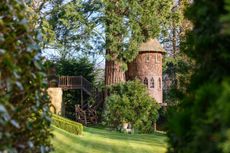 The treehouse of your dreams is for sale, and it even comes with a country house
The treehouse of your dreams is for sale, and it even comes with a country houseThe only thing more impressive than the treehouse at Springfield House are the recently re-designed interiors.
By James Fisher Published
-
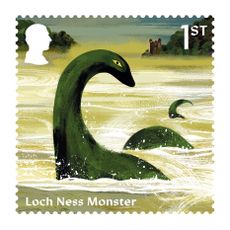 You've got mail: Royal Mail unveils eight folklore-inspired stamps
You've got mail: Royal Mail unveils eight folklore-inspired stampsThe Loch Ness monster is among Britain's mythical beings that appear on the stamps.
By Annunciata Elwes Published
